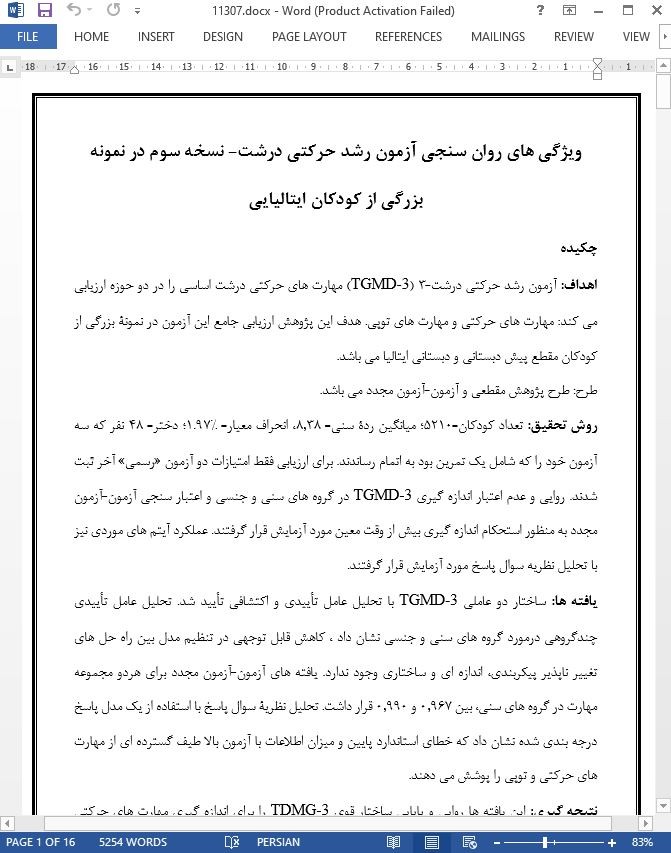
ویژگی های روان سنجی آزمون رشد حرکتی درشت
چکیده
اهداف: آزمون رشد حرکتی درشت-3 (TGMD-3) مهارت های حرکتی درشت اساسی را در دو حوزه ارزیابی می کند: مهارت های حرکتی و مهارت های توپی. هدف این پژوهش ارزیابی جامع این آزمون در نمونۀ بزرگی از کودکان مقطع پیش دبستانی و دبستانی ایتالیا می باشد.
طرح: طرح پژوهش مقطعی و آزمون-آزمون مجدد می باشد.
روش تحقیق: تعداد کودکان=5210؛ میانگین ردۀ سنی= 8.38، انحراف معیار= 1.97%؛ دختر= 48 نفر که سه آزمون خود را که شامل یک تمرین بود به اتمام رساندند. برای ارزیابی فقط امتیازات دو آزمون «رسمی» آخر ثبت شدند. روایی و عدم اعتبار اندازه گیری TGMD-3 در گروه های سنی و جنسی و اعتبار سنجی آزمون-آزمون مجدد به منظور استحکام اندازه گیری بیش از وقت معین مورد آزمایش قرار گرفتند. عملکرد آیتم های موردی نیز با تحلیل نظریه سوال پاسخ مورد آزمایش قرار گرفتند.
یافته ها: ساختار دو عاملی TGMD-3 با تحلیل عامل تأییدی و اکتشافی تأیید شد. تحلیل عامل تأییدی چندگروهی درمورد گروه های سنی و جنسی نشان داد ، کاهش قابل توجهی در تنظیم مدل بین راه حل های تغییر ناپذیر پیکربندی، اندازه ای و ساختاری وجود ندارد. یافته های آزمون-آزمون مجدد برای هردو مجموعه مهارت در گروه های سنی، بین 0.967 و 0.990 قرار داشت. تحلیل نظریۀ سوال پاسخ با استفاده از یک مدل پاسخ درجه بندی شده نشان داد که خطای استاندارد پایین و میزان اطلاعات با آزمون بالا طیف گسترده ای از مهارت های حرکتی و توپی را پوشش می دهند.
نتیجه گیری: این یافته ها روایی و پایایی ساختار قوی TDMG-3 را برای اندازه گیری مهارت های حرکتی درشت در گروه های جنسی و سنی کودکان را نشان می دهد. تحلیل نظریۀ سوال پاسخ نشان می دهد که چگونه معیارهای عملکردی موجود در این آزمون طیف گسترده ای از مهارت های حرکتی درشت را دربر گرفته اند. استفاده از TGMD-3 می تواند موجب آگاهی برنامه های رشد حرکتی شده و از تصیمات برنامۀ درسی مدارس حمایت کند.
5. نتیجه گیری
TGMD-3 ابزاری مطمئن برای ارزیابی مهارت های حرکتی درشت در کودکان پیش دبستانی و دبستانی است. این ابزار به طور همزمان می تواند بین پسرها و دخترها با ردۀ سنی 3 تا 11 سال مورد استفاده قرار گیرد. استفاده از TGMD-3 می تواند برنامه های رشد حرکتی را آگاه سازد و از تصمیم گیری های برنامۀ درسی در مدارس حمایت کند. به طور خلاصه، یافته های ما دارای پیامدهای مهمی در موقعیت آموزشی است که برای تأیید رشد حرکتی بین کودکان با روشی معتبر بسیار مهم است.1 بنابراین TGMD-3 می تواند ابزاری بسیار مفید برای محققان و معلم ها به منظور شناسایی تأخیر حرکت و صلاحیت حرکت در رشد مهارت حرکتی درشت کودکان باشد.
Abstract
Objectives The Test of Gross Motor Development-3 (TGMD-3) evaluates fundamental gross motor skills across two domains: locomotor and ball skills. This study aimed to perform a full psychometric assessment of this test in a large sample of Italian pre- and primary school children.
Design Cross-sectional and test-retest study design.
Method Children N = 5210; mean age years = 8.38, SD = 1.97; % females = 48 completed three trials, including one practice. Only the scores of the two latter ‘formal’ trials were recorded for the evaluation. Factorial validity and measurement invariance of TGMD-3 across age and gender groups and test-retest reliability for the overtime measure consistency were tested. Item response theory analysis further tested single items’ performances.
Results Explorative and confirmatory factor analyses confirmed the two-factor structure of the TGMD-3. Multi-group confirmatory factor analyses indicated that there were no significant reductions in model adjustments between the configural, metric and structural invariance solutions for gender and age groups. Test-retest results ranged between 0.967 and 0.990 for both skill sets across age groups. Item response theory analysis using a graded response model showed low standard error and high-test information levels covering a wide spectrum range of both locomotor and ball skills.
Conclusions These results highlight the strong construct validity and reliability of the TGMD-3 to measure gross motor skills in children across gender and age groups. Item response theory analysis evidenced how the performance criteria included in this test cover a wide range of gross the motor skills spectrum. The use of TGMD-3 may inform motor development programs and support curricular decisions in schools.
5. Conclusion
The TGMD-3 is a reliable instrument to assess gross motor skills in pre- and primary school children. This instrument can be simultaneously adopted across boys and girls with age range from 3 to 11 years. The use of TGMD-3 may inform motor development programs and support curricular decisions in schools. In sum, our results have significant implications in educational settings where it is important to verify in a reliable way motor development among children. This is crucial if we consider how important motor developmentis in childhood.1 The TGMD-3 may thus be a very useful instrument for researchers and teachers to identify children’s motor delays and motor competence in gross motor skill development.
چکیده
1. مقدمه
2. روش ها
3. یافته ها
4. بحث
5. نتیجه گیری
Abstract
1. Introduction
2. Methods
3. Results
4. Discussion
5. Conclusion
- اصل مقاله انگلیسی با فرمت ورد (word) با قابلیت ویرایش
- ترجمه فارسی مقاله با فرمت ورد (word) با قابلیت ویرایش، بدون آرم سایت ای ترجمه
- ترجمه فارسی مقاله با فرمت pdf، بدون آرم سایت ای ترجمه



